
Loquats are native to China and have a long history of cultivation. As early as the Han Dynasty, loquats were cultivated. In the Tang Dynasty, Liu Zongyuan once said that "the citrus pomelo is honored in the early winter, and the loquat is recommended in the summer." Pick up all the loquats and one tree of gold." Shen Zhou of the Ming Dynasty loved loquats, not only did he have a number of loquat paintings that were handed down from time to time, but there were often poems inscribed on the paintings. Round and full, sweet and cool lips. Gold is used for food, and the sky is longevity for Wu people."
In addition to poetry, there are also many famous works of painting and calligraphy depicting loquats in the past dynasties. For example, the loquats painted by Zhao Ji, Huizong of the Northern Song Dynasty, were painted with ink and wash. , or painted in light colors, with a literati interest; the loquats written by Wu Changshuo and Wang Zhen during the Republic of China were written in the way of seal script, which is very interesting of gold and stone.
In this early summer, The Paper hereby sorts out the famous loquats in calligraphy and painting of past dynasties for readers.

The first fruit of early summer - Suzhou Dongshan Baiyu loquat
Song Zhaoji Loquat Mountain Bird Map Page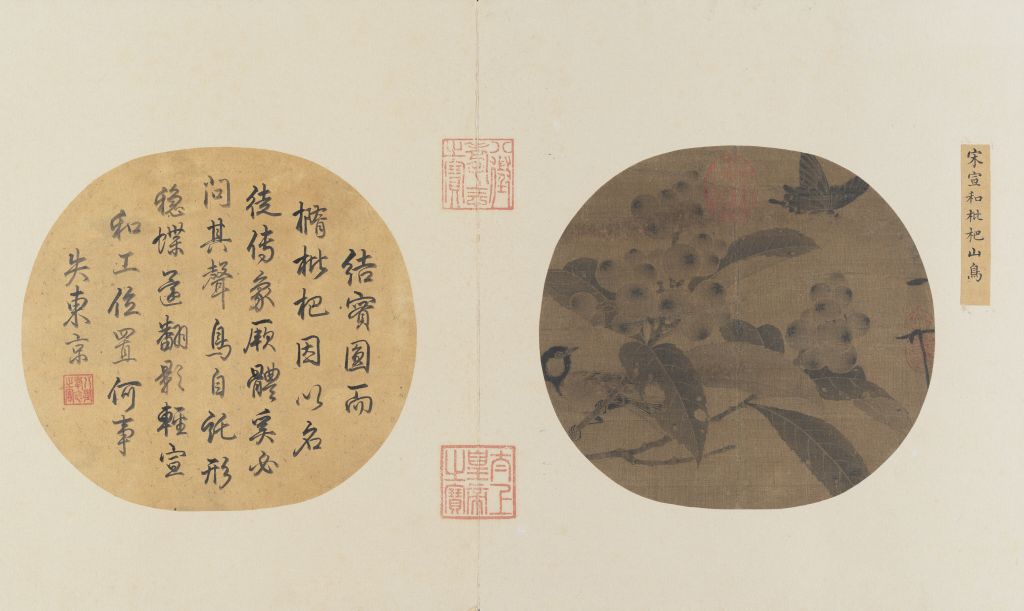
Song Zhaoji, Loquat Mountain Aerial Page Collection of the Palace Museum
The loquat in the picture is full of fruits and prosperous branches and leaves. A tit perched on a branch, looking back at the fluttering swallowtail butterfly with a vivid expression. This picture shows the body of Cui Baiqing. Song Huizong Zhao Ji's paintings of flowers and birds are mostly colored. However, this painting is purely painted with ink and wash. It is elegant in style, slightly like a boneless painting, and has a vigorous and delicate charm, which reflects Zhao Ji's various painting talents. .On the folio is a poem inscribed by Emperor Qianlong of the Qing Dynasty: "Sturdy, round and oval, the loquat is famous for its name. If the body of the elephant is passed down, Xi will ask its sound. The bird's shape is stable, and the butterfly's shadow is light. Lost Tokyo." I felt that Song Huizong was so good at painting, working on composition and business location, why did he lose his country?
Song Xu Chongsi's loquat ribbon

Song Xu Chongsi's Loquat Ribbon Belt
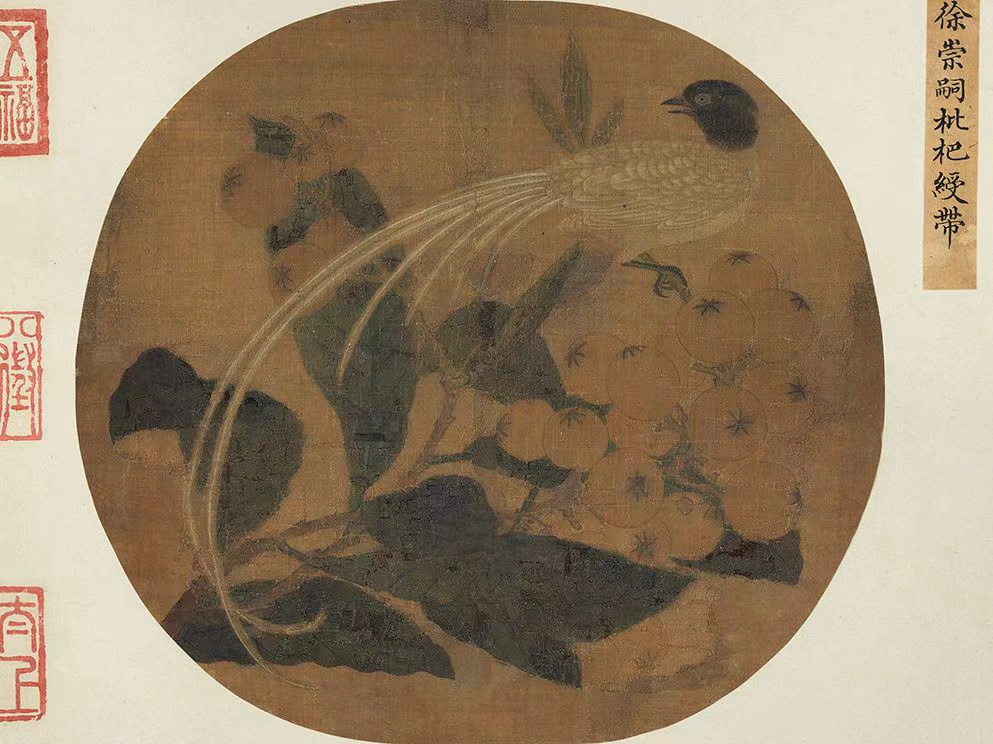
Song Xu Chongsi's Loquat Ribbon Belt
Xu Chongsi, a painter of the Northern Song Dynasty. Xu Xisun. He is good at painting grass and insects, poultry and fish, vegetables and fruits, flowers and trees and silkworm cocoons. His painting was originally a family study, but because it did not conform to the program and fashion of the painting academy at that time, he changed his studies to Huang Quan and Huang Jucai and his son. Later, he created his own style, and he did not use ink pen to outline, but directly smudged it with color. Brother Xu Chongxun and younger brother Xu Chongju are both good at painting flowers and birds, and Chongju is also a craftsman.
Song Xu Chongsi Loquat Ribbon (Part)
Qing Gaozong's postscript to the script: Cut for the boneless self-proclaimed high, implying that Zhifei served as Rucao. Not to mention that there are many things in the heat, Taiyuan has long been wearing a Yu Lun robe.Song Tuo Tang Taizong loquat post
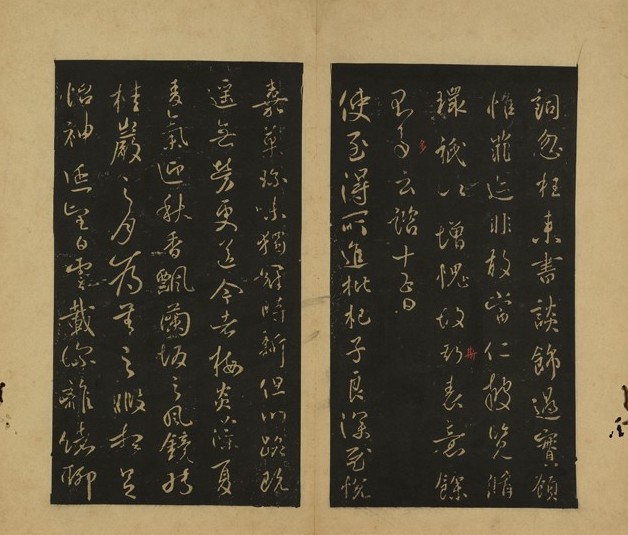
Song Tuo Tang Taizong's Loquat Post This piece is selected from the "Daguan Post (1) Volume" collected by the National Palace Museum in Taipei
Interpretation: When you arrive, you get the loquats that you get, which is very comforting. Jiaguo is a rare delicacy, and it is always new, but the Sichuan Road is far away, so it is more convenient to send it without labor. Today, the plum blossoms and algae are in the summer, the wheat gas welcomes the autumn, the fragrance floats in the wind of Lanban, and the mirror turns to the moon of Guiyan. Looking at the white clouds, carrying deep thoughts, chatting with green words, there is not much to say. Consultation, 29th.Song Linchun Loquat Mountain Aerial Picture Page

Song Linchun Loquat Mountain Aerial Page Collection of the Palace Museum
In May in the south of the Yangtze River, the ripe loquat fruit is particularly attractive in the summer light. A loquat with embroidered eyes and tail turned its neck was sitting on a loquat branch and was about to peck at the fruit, but found an ant on it. The loquat branches seem to vibrate up and down as the center of gravity of the embroidered eye is out of balance. The picture is still and moving, full of fun. The feathers of the embroidered eyes are first smeared with color and ink, and then depicted with small but not rigid brushstrokes, showing the different textures of the bird's back feathers being firm and smooth, while the belly hairs are fluffy and soft. The loquat fruit is outlined with earthy yellow lines, then filled with golden yellow, and finally painted with ochre color. The three different warm colors blend together, thus showing the plump and sweetness of the loquat fruit at the ripe stage. The loquat leaves are represented by the neat and delicate heavy-color method, which not only faithfully depicts the various natural shapes of the leaf surface reverse to the back, but also traces the damage traces of the leaf surface by insect bites meticulously, which fully reflects the The artistic level achieved by the flower and bird painting in the Song Dynasty in terms of realism.Song Lidi loquat Youque

This painting is selected from the "Paintings of the Song and Yuan Dynasties" in the National Palace Museum, Taipei
Li Di (1100-1197). A painter in the Southern Song Dynasty, from Heyang (now Mengzhou City, Henan Province).There are many works of Li Di handed down from generation to generation, and most of them have vintage models. In the first year of Chunxi (1174), the scroll "Wind and Rain Returning to Herdsmanship" is now in the National Palace Museum, Taipei; in the 14th year of Chunxi (1187), the scroll "Snow Trees and Birds" is now in the Shanghai Museum. In the second year of Qingyuan period (1196), he made a scroll of "Maple Eagle and Pheasant", and in the third year of Qingyuan (1197) "Chicken Feeding" album, "Hound" album, all of which are in the Palace Museum. Zi Demao, in the reign of Lizong Chunyou (1241-1252), was waiting for an imperial edict. Painting inherits the family method, and likes painting flowers, birds, eagles and falcons, but the wild scenery is not as good as his father. The last date of the Li painting that I have seen is the third year of Qingyuan (1197). If it goes back to the seventh year of Xuanhe in the Northern Song Dynasty (1125), it takes seventy-three years. Based on this calculation, the age of Li's existence should be over ninety. .
Song Cuibai's painting of loquat and peacock axis

Song Cuibai's painting of loquat and peacock scrolls in the collection of the National Palace Museum, Taipei
Cui Bai (active in the 11th century), courtesy name Zixi, was a native of Haoliang (now Fengyang, Anhui), and was selected by Renzong (1022-1063) to study in the Painting Academy. He is good at painting flowers and birds, especially flowers and bamboos, mountain rabbits, withered lotuses, water mallards, wild geese and the like.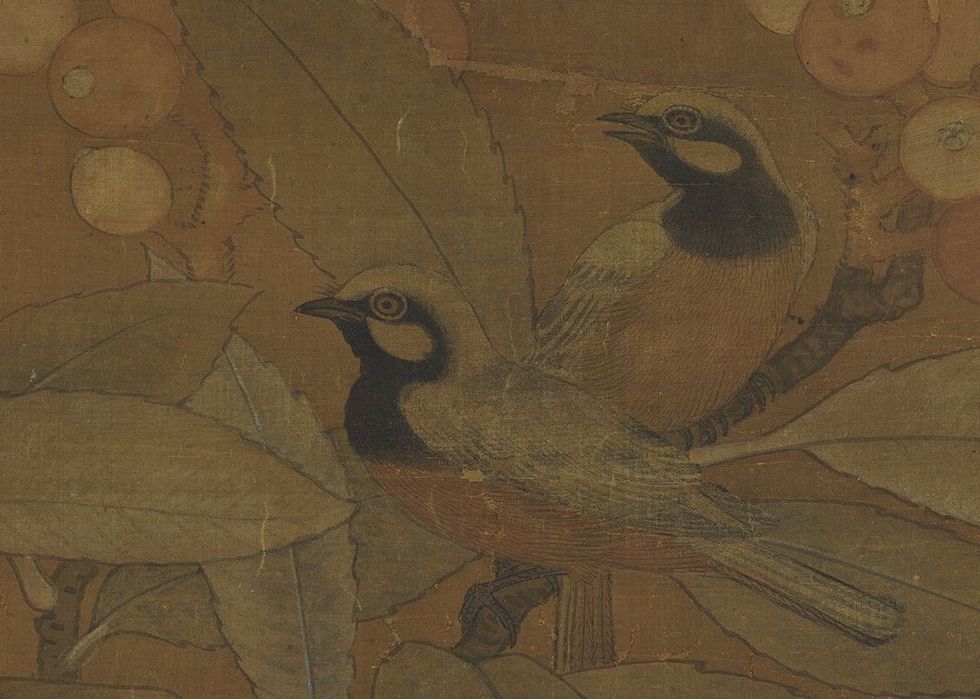
Song Cuibai's loquat and peacock scroll (part) Collection of the National Palace Museum, Taipei

Song Cuibai's loquat and peacock scroll (part) Collection of the National Palace Museum, Taipei
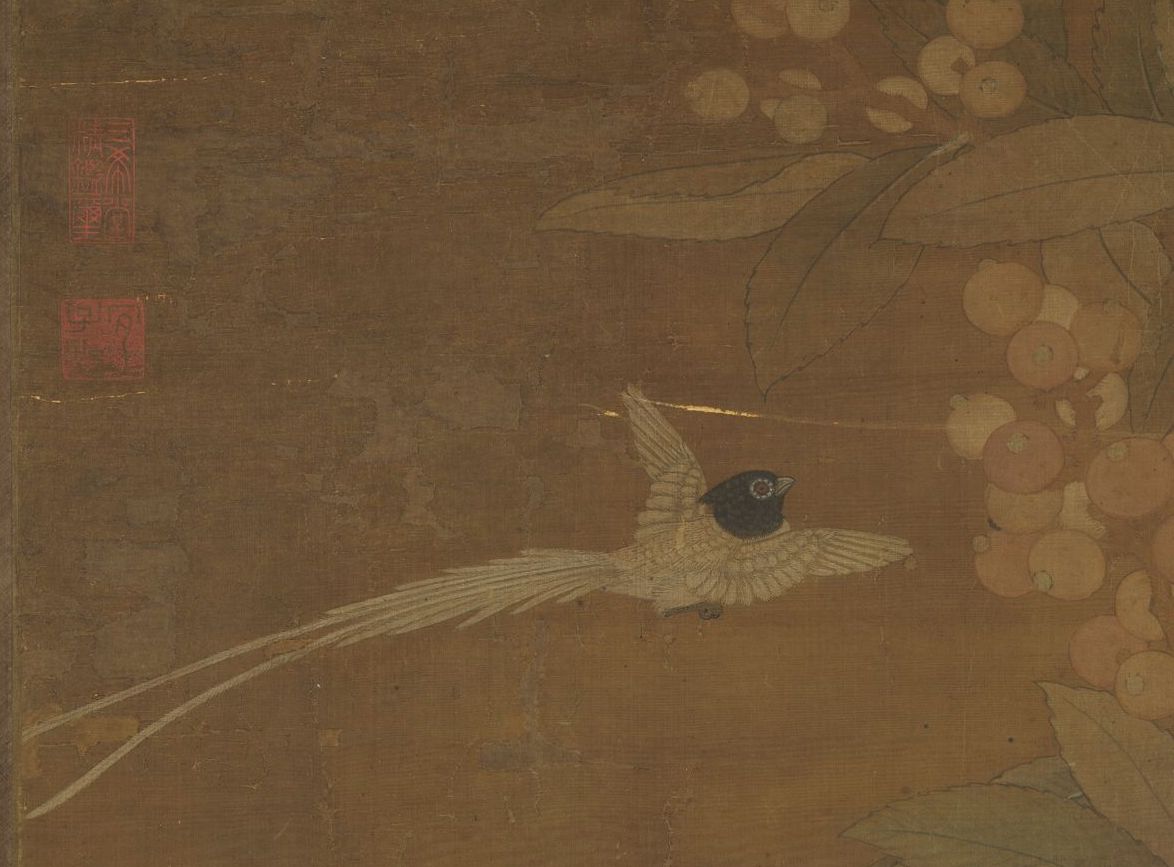
Song Cuibai's loquat and peacock scroll (part) Collection of the National Palace Museum, Taipei
In this painting, under the loquat tree, there are a pair of peacocks, one is parked on the trunk, the other is walking among the flowers, with a ribbon bird flying overhead, and various flowers are blooming beside the rocks of Taihu Lake. The whole picture is covered with patterns, the coloring is bright, and the picture is very lively and rich.Song Dynasty Broken Branches and Loquat Axis

Song Dynasty Broken Branches Loquat Scroll Collection of the National Palace Museum, Taipei

Song Dynasty Broken Branch and Loquat Scroll (Part) Collection of the National Palace Museum, Taipei
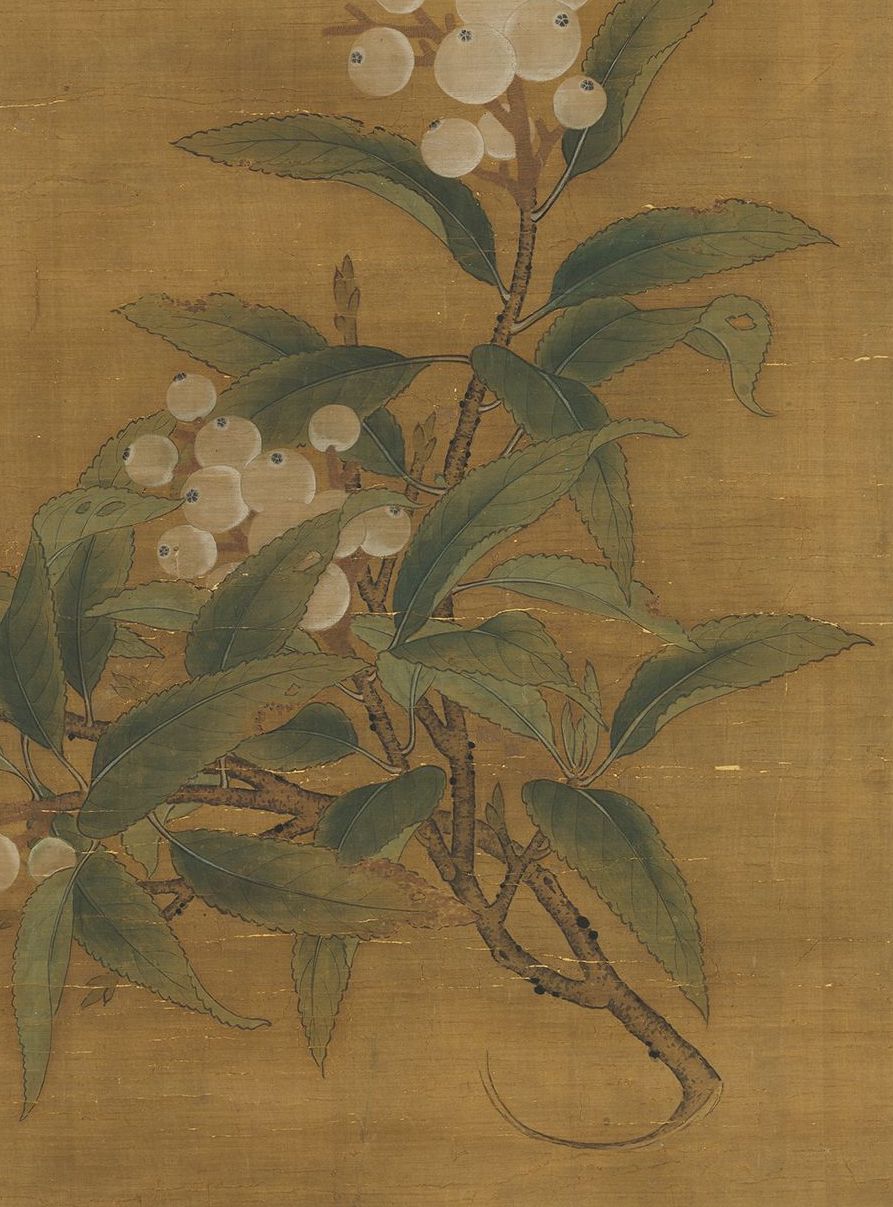
Song Dynasty Broken Branch and Loquat Scroll (Part) Collection of the National Palace Museum, Taipei
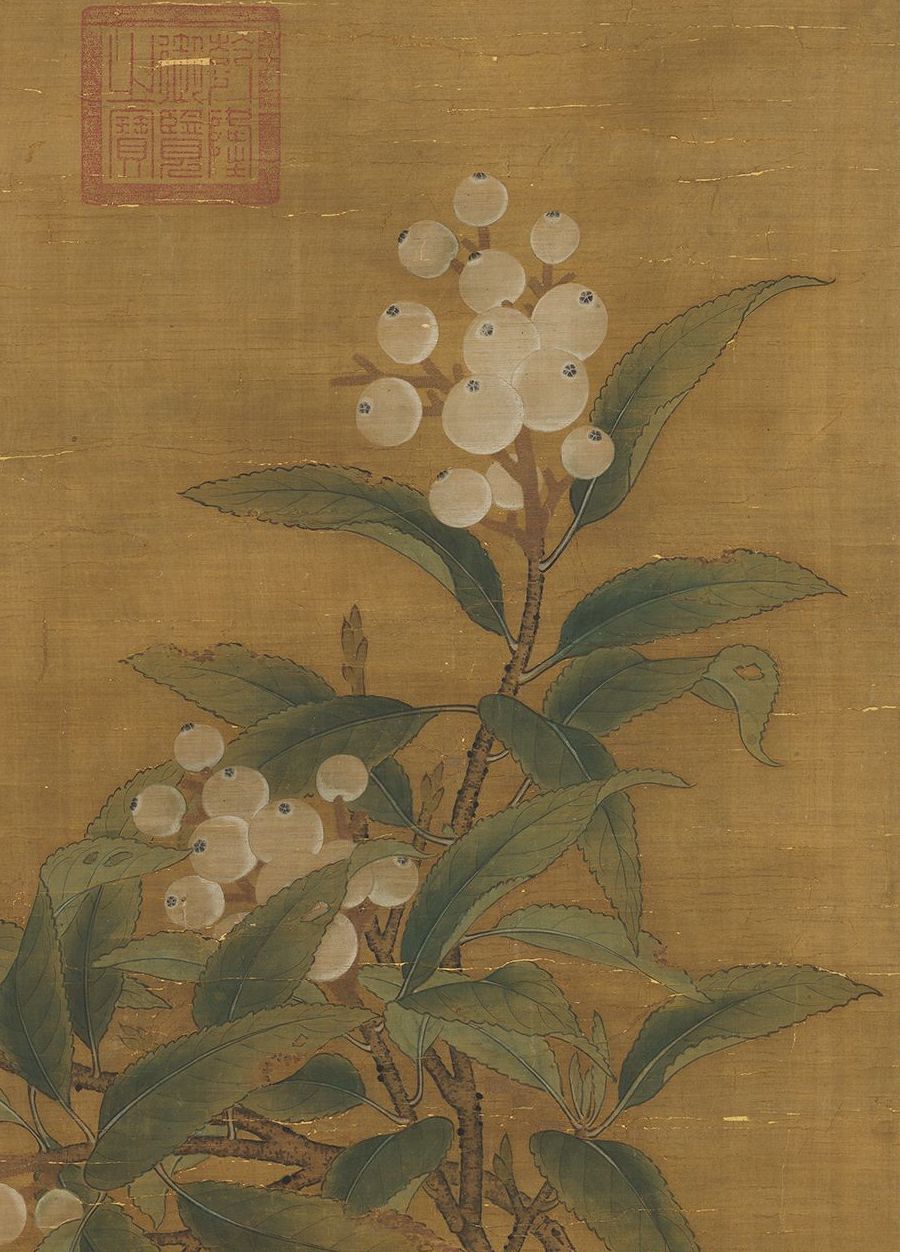
Song Dynasty Broken Branch and Loquat Scroll (Part) Collection of the National Palace Museum, Taipei
Ming Shen Zhou loquat chart axis
Ming Shen Zhou's "Loquat Scroll" Collection of the Palace Museum
Ming Shen Zhou loquat
Ming Shen Zhou's loquat This painting is selected from Shen Zhou's "Reclining Travel Atlas" in the Palace Museum
The name of "recumbent travel" comes from the allusions of Song Zongbing in the Southern Dynasty hanging landscapes on the four walls of his bedroom to travel in bed. However, unlike the hanging scroll, the atlas can also be read on the back while lying in bed. This shows the artist's original intention of painting and the taste of life.The loquat is selected from the seventh book of "Reclining Travel Atlas", and the artist on the upper right inscribed: "The elastic is round and filling, the sweetness is cool and the lips are cool. The gold is used for food, and the sky is longevity. Wu people. Shen Zhou."
Ming Shen Zhou painting loquat scroll
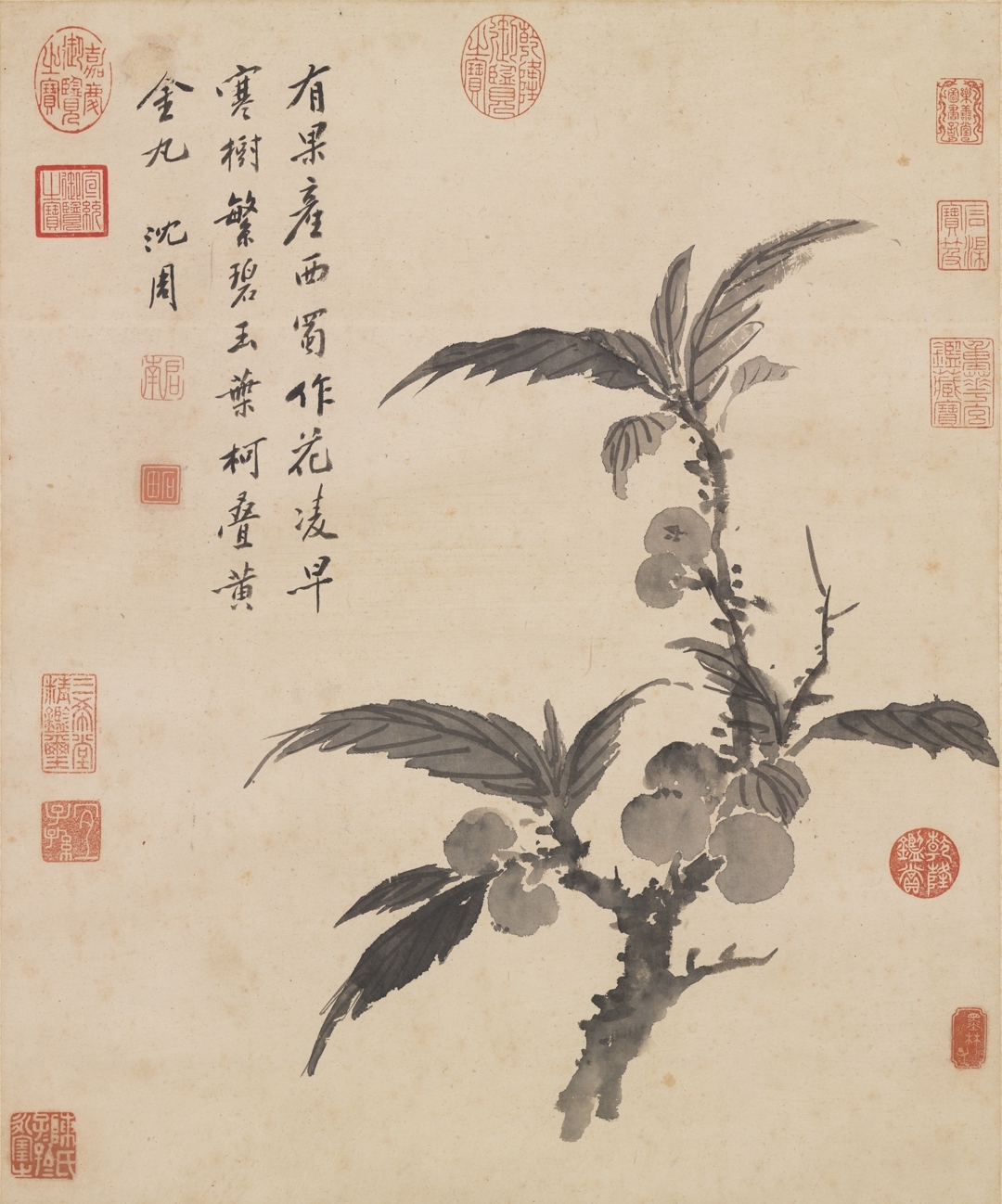
Ming Shen Zhou painting Loquat Scroll Collection of the National Palace Museum, Taipei
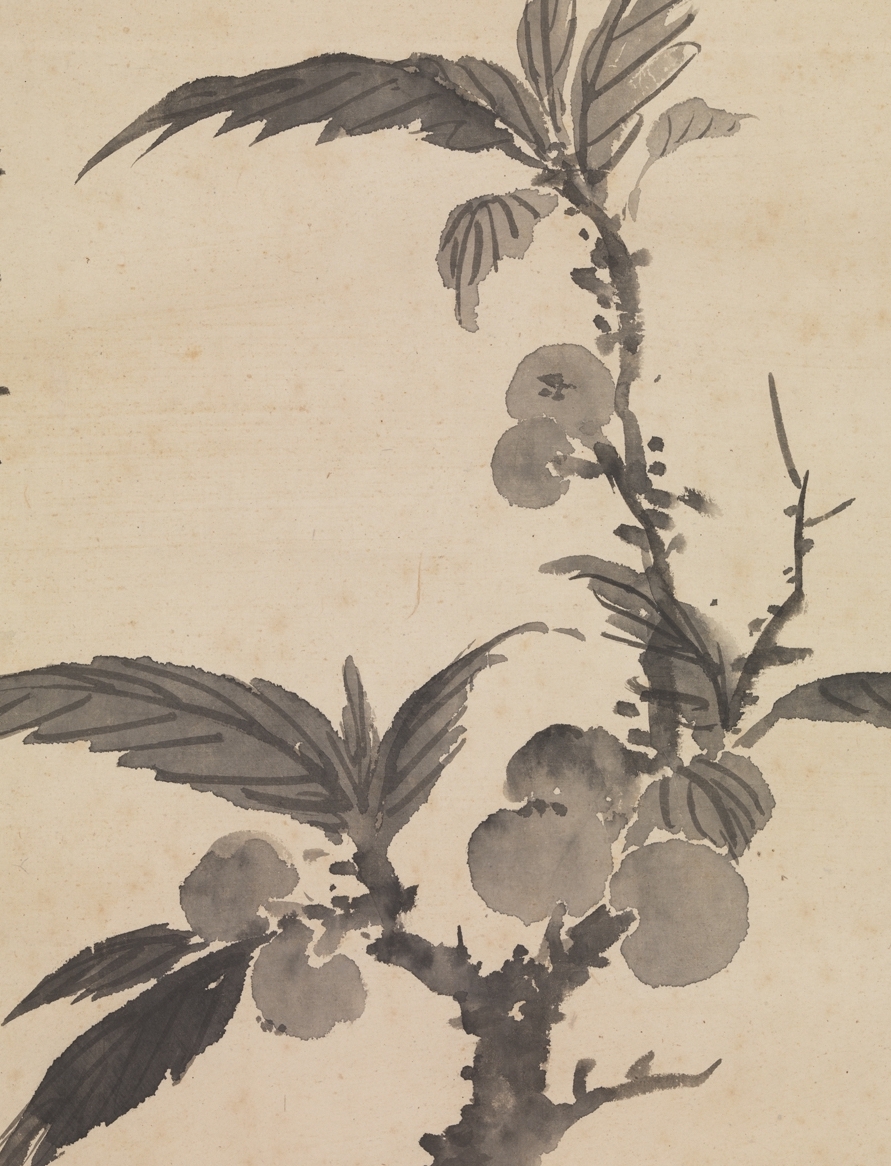
A loquat scroll painted by Shen and Zhou of the Ming Dynasty (detail) Collection of the National Palace Museum, Taipei
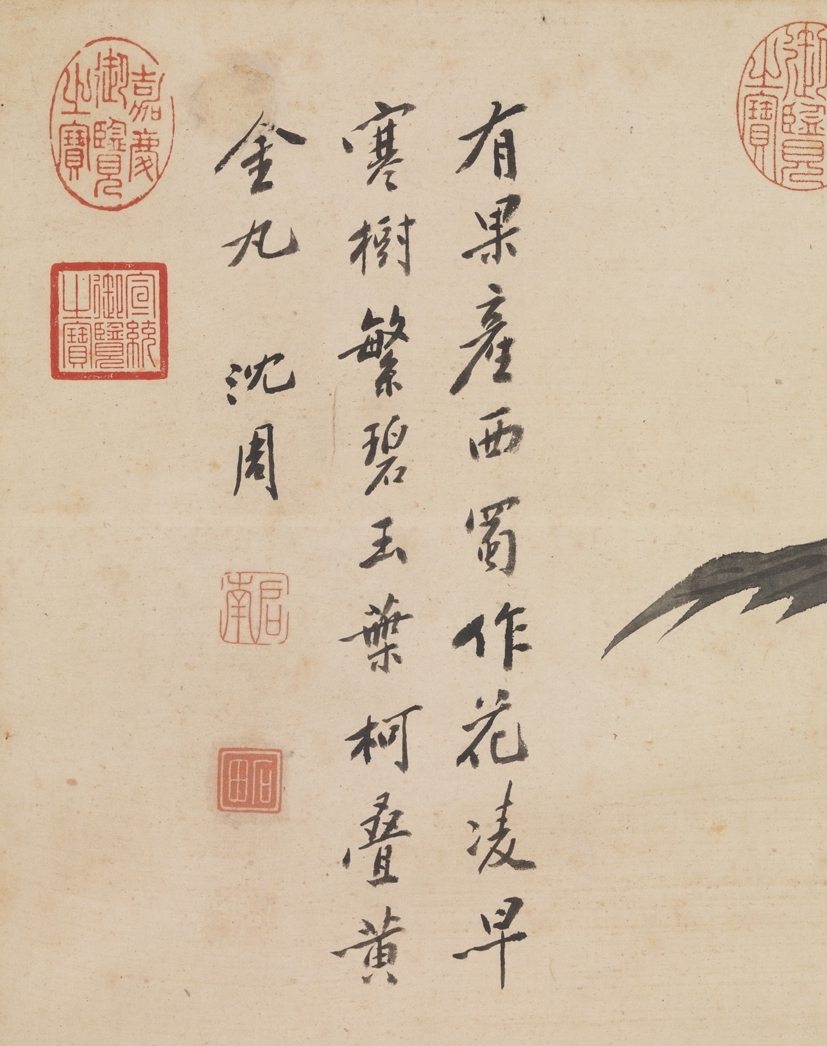
A loquat scroll painted by Shen and Zhou of the Ming Dynasty (detail) Collection of the National Palace Museum, Taipei
Shen Zhouxing wrote in regular script: There are fruits produced in Xishu, and flowers are produced in Ling Zaohan. Trees with jasper leaves, Ke stacks of golden pills. Shen Zhou.Ming Shenzhou painting loquat
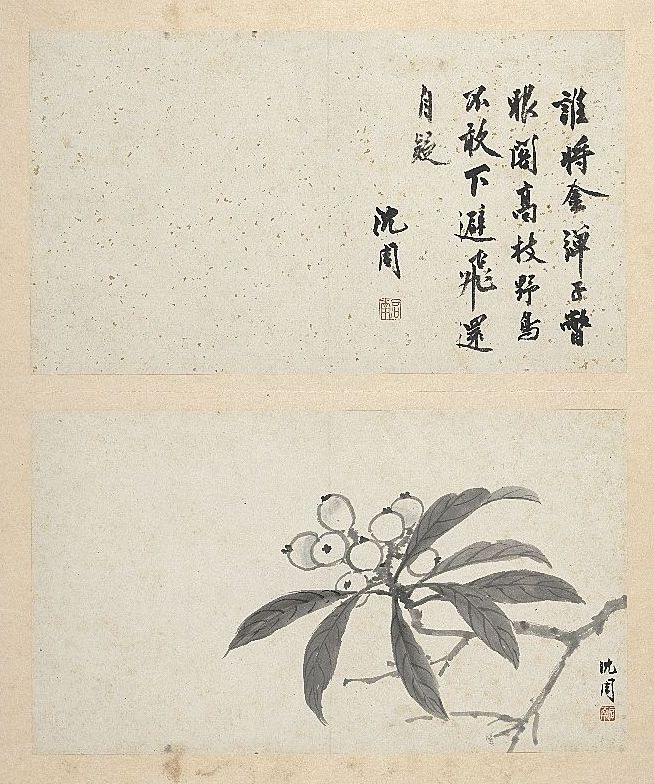
Ming Shen Zhou's painting of loquats
Shen Zhou inscribed himself in writing: Who will take the golden marbles and glance at the high branches of the pavilion. Wild birds dare not go down, and they are suspicious of avoiding flying. Shen Zhou.Ming Luzhi seal and waiting map

Scroll of the Ming Dynasty and Lu Zhifeng, the collection of the National Palace Museum, Taipei
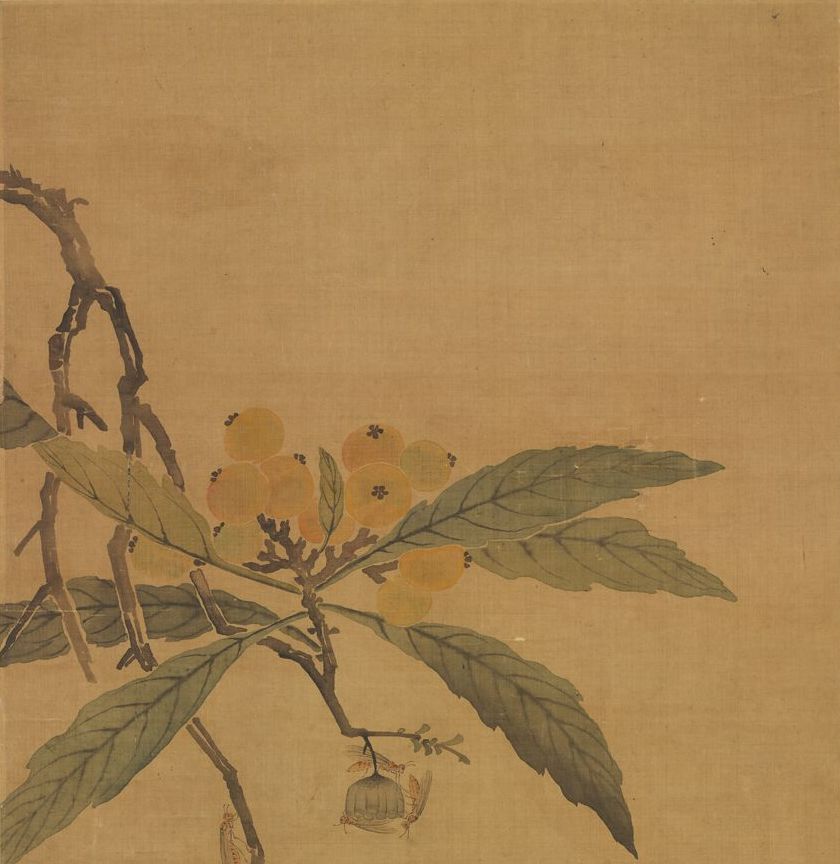
Scroll of the Ming Dynasty and Lu Zhifeng (part) Collection of the National Palace Museum, Taipei
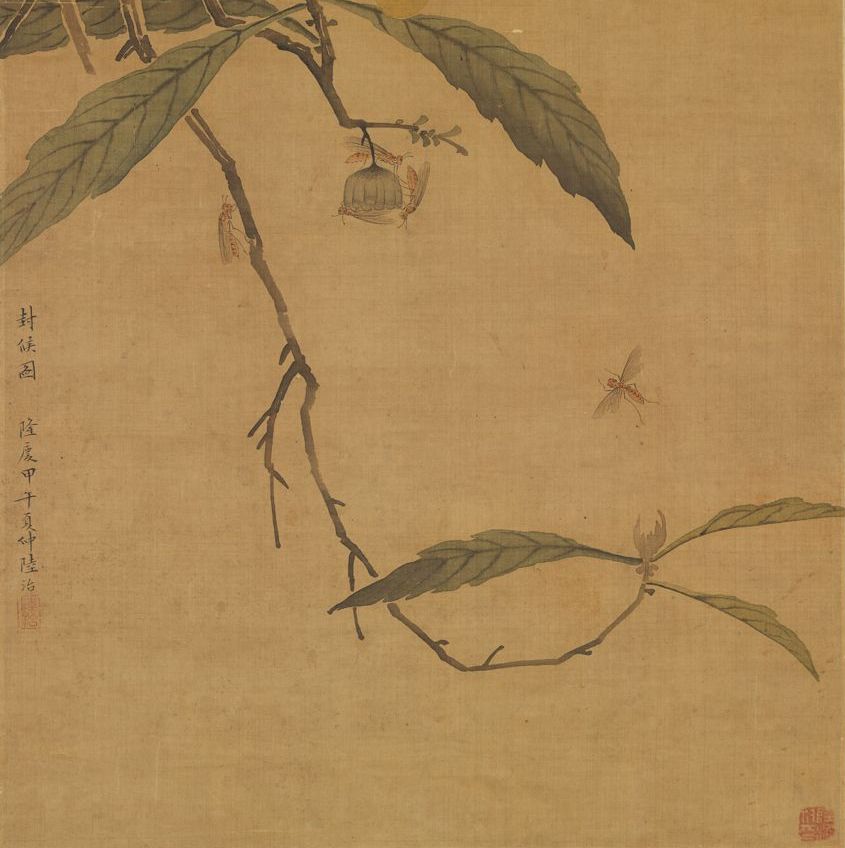
Scroll of the Ming Dynasty and Lu Zhifeng (part) Collection of the National Palace Museum, Taipei
Ming and Zhou Dynasty Mian Loquat Rare Bird Shaft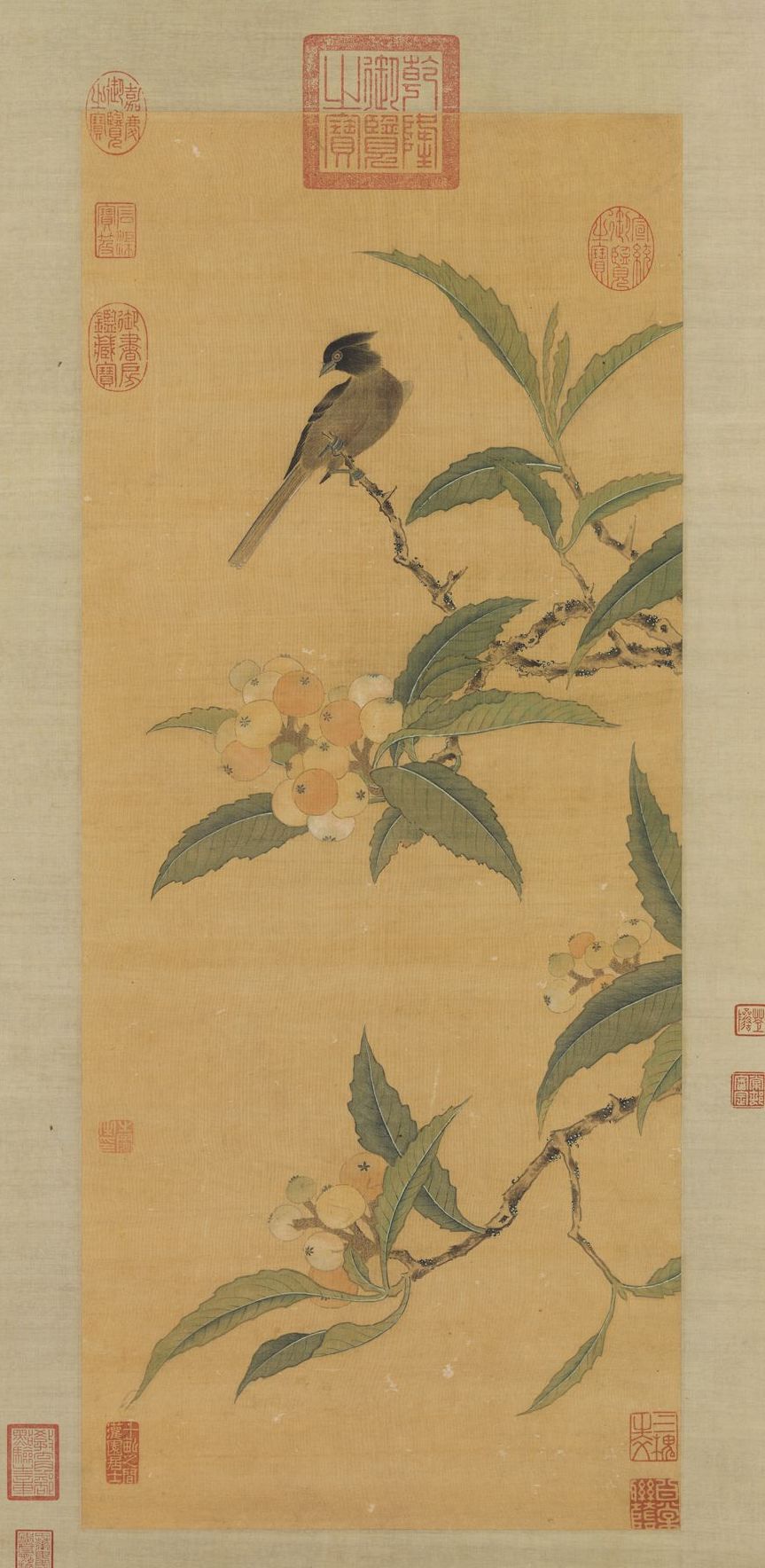
Ming and Zhou Mian Loquat Rare Bird Scroll Collection of the National Palace Museum, Taipei
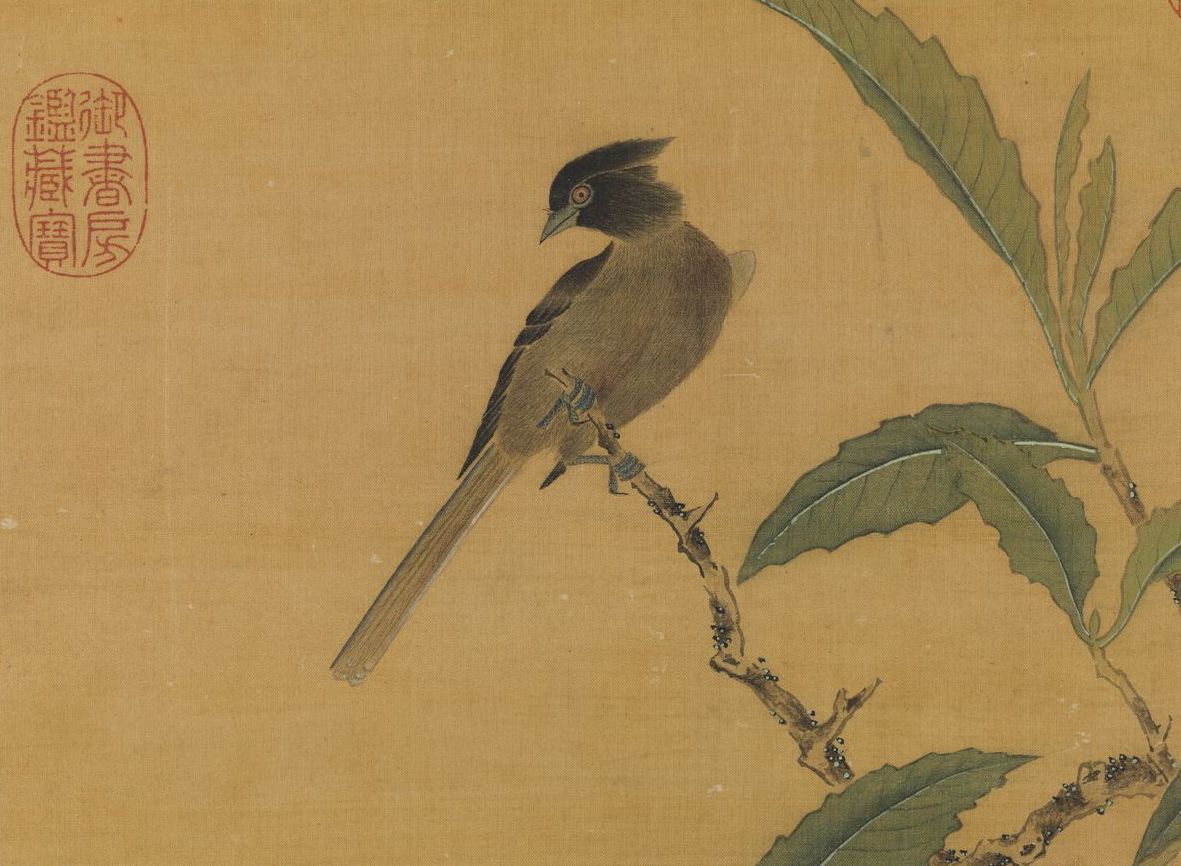
Ming and Zhou Dynasties, Loquat Rare Bird Scroll (Part) Collection of the National Palace Museum, Taipei
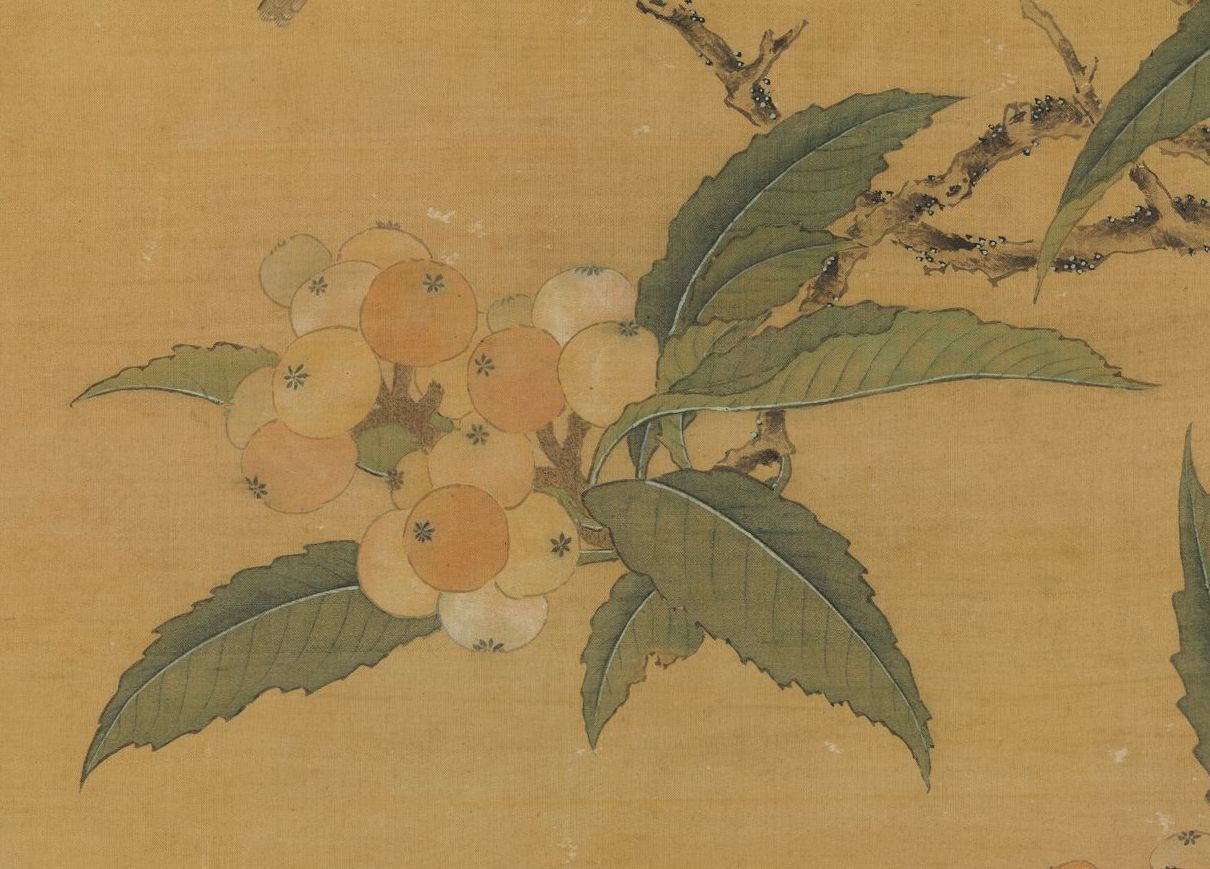
Ming and Zhou Dynasties, Loquat Rare Bird Scroll (Part) Collection of the National Palace Museum, Taipei
Ming Chen Jiayan loquat squirrel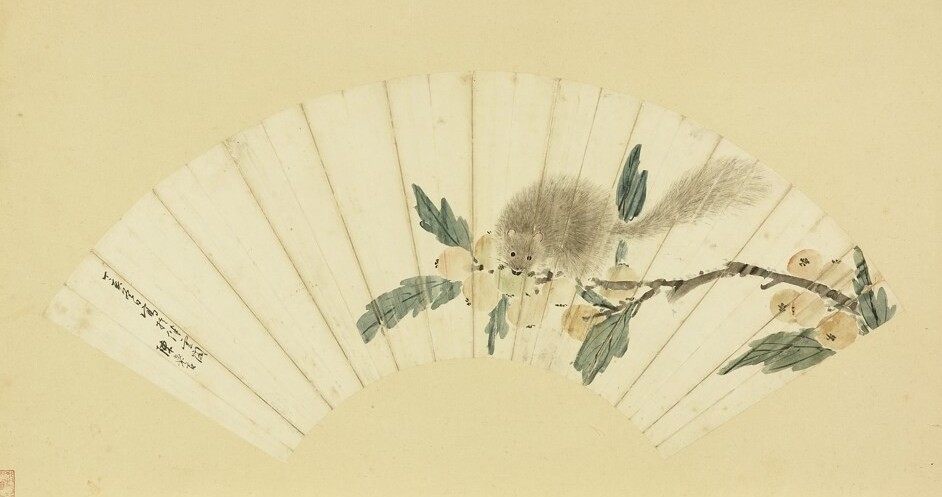
Ming Chen Jiayan Loquat Squirrel This painting is selected from the "Celebrity Painting Fan Album" collected by the National Palace Museum in Taipei
Chen Jiayan (1539-?), courtesy name Kong Zhang, was born in Jiaxing, Zhejiang. Good at writing flowers and birds. The brush is loose and beautiful, and it is quite wonderful. This picture is fresh in its meaning and elegant in color. It depicts the loquat's mellowness and freshness with boneless and freehand brushwork, and the squirrels gnawing on the loquat among the branches and leaves are full of fluffy and cute cilia. It is the artist's uniqueness that the freehand fruits and fine hairs on the canvas can be so delicately matched.Plain text from simple loquat

Mingwen Congjian loquat This painting is selected from the "Mingren Instant Noodles Painting Album (3)" in the National Palace Museum, Taipei
Wen Congjian (1574-1648), courtesy name Yanke, old man of pillow smoke, was a native of Changzhou (now Suzhou, Jiangsu), Suzhou Prefecture, southern Zhili. Great-grandson of the great calligrapher and painter Wen Zhengming, a painter in the late Ming and early Qing dynasties. In the thirteenth year of Chongzhen (1640), he paid tribute, and after entering the Qing Dynasty, he retired to the forest and entertained himself with calligraphy and painting.Qingyun Shouping Loquat

Qing Yun Shouping Loquat This piece is selected from Yun Shouping's "Painting Flowers" in the National Palace Museum, Taipei
Yun Shou's parallel book self-title: Throwing golden fruit at the pen end, disdain for Nagato to buy money. Ouxiang Pavilion play map.Qing Zhang Ruo Ai Loquat
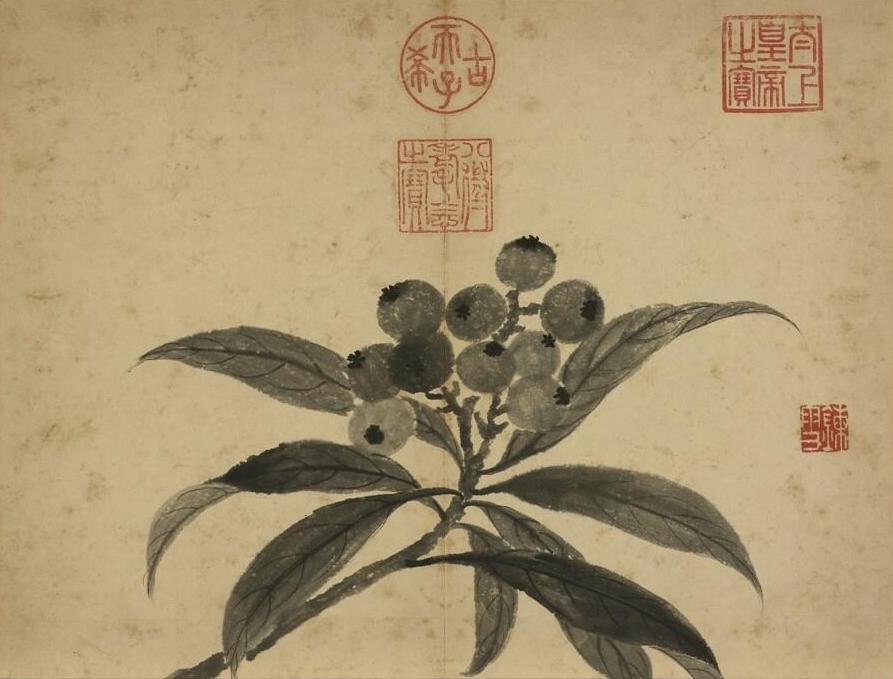
Zhang Ruoai, Qing Dynasty Loquats This painting is selected from Zhang Ruoai's "Sketch of Flowers and Fruits" in the National Palace Museum, Taipei
Zhang Ruoai (1713-1746). The word Qinglan (the name is Jingcai, the name is Qinglan), the name of the house is Ouxiang Bookstore, and he is a native of Tongcheng, Anhui Province. Zhang Ruoai had a family education. His grandfather was Zhang Ying, a scholar of the Wenhua Palace of the Kangxi Dynasty, and his father was Zhang Tingyu, a scholar of the Baohe Palace of the Yongzheng and Qianlong dynasties.In the eleventh year of Yongzheng's reign (1733), he was ranked third in the first grade and third in the gold medal list of the Gui Chou Ke Palace. At the request of his father Zhang Tingyu "to give it to the world's cold scholars", he was downgraded to the second grade and a jinshi. Xiu, the emperor personally conferred a cabinet degree and a minister of the Ministry of Rites, entered the Zhinan study, and became an official to the Ministry of Rites, and became an earl.
Zhang Ruoai worshipped the inner court with calligraphy and paintings, and one day the queen mother gave out a square inch jade pendant and ordered a book of the Heart Sutra. It's just a matter of time, because the gift above is worthless. He was good at painting landscapes, flowers and birds, and received the will of Wang Hongxiang and Zhou Zhimian. In the eleventh year of Qianlong's reign (1746), he went on a western tour with the emperor and returned to Beijing due to illness.
Qing no money loquat
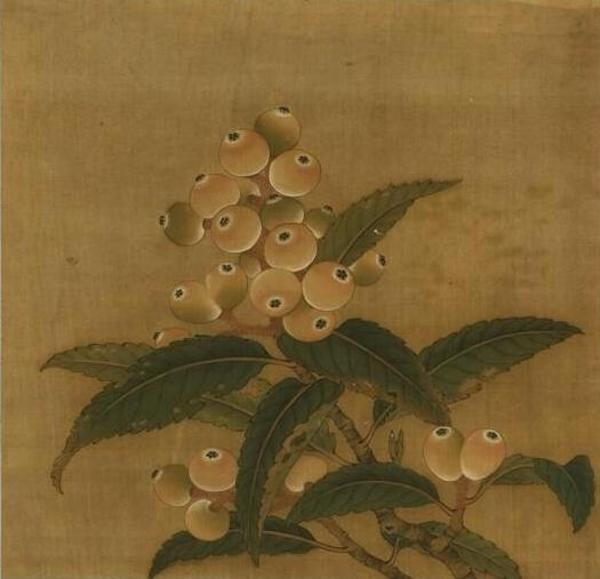
Unmarked Loquat, Qing Dynasty
Picture of bee on loquat and loquat in Puxin in the Republic of China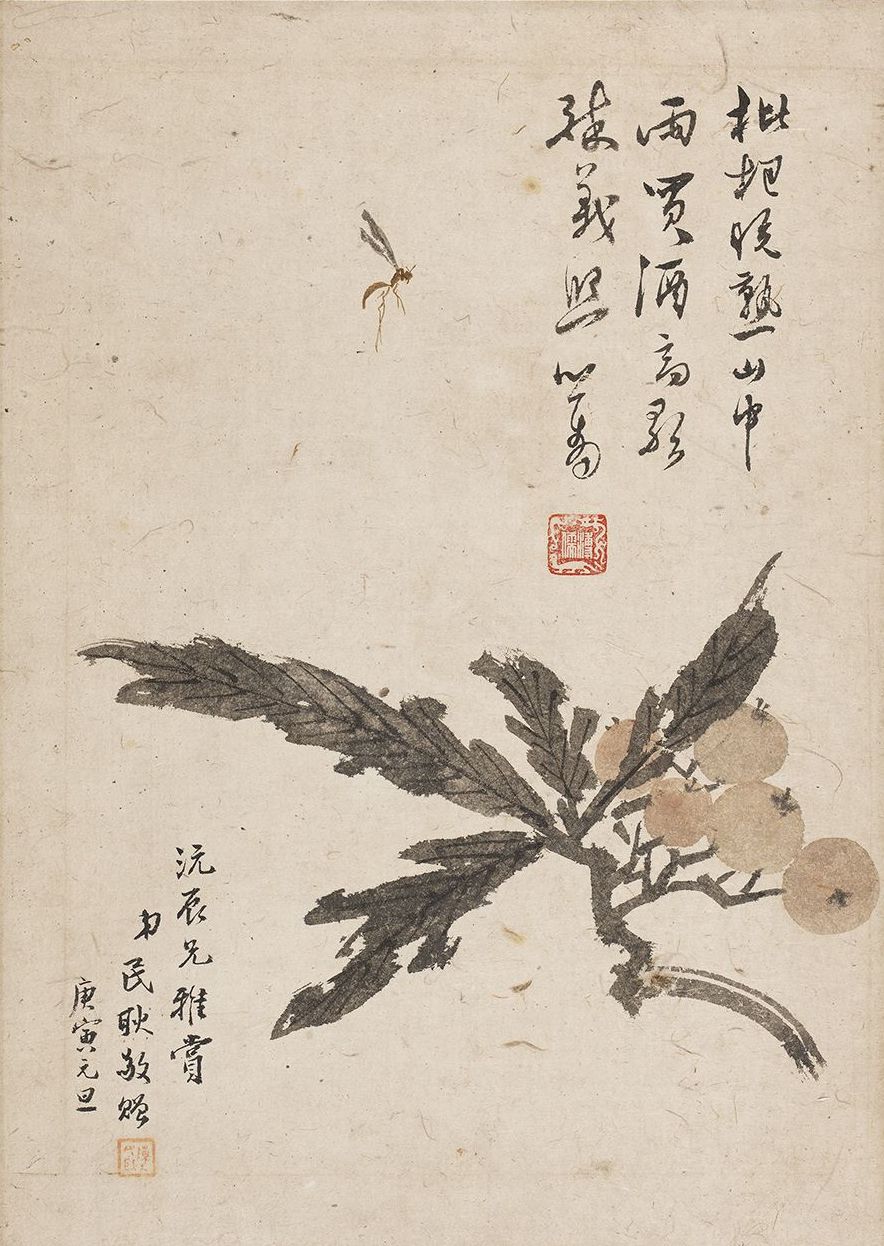
A picture of a loquat and a bee in Puxin, the Republic of China, in the collection of the National Palace Museum, Taipei
Pu Xinshe (1896.9.2—1963.11.18), Manchu, formerly known as Aisin Gioro Pu Ru, first word Zhongheng, changed word Xinshe, self-named Emperor Xi, Xishan Yishi, Beijing native, famous calligrapher and painter ,collector. He is the grandson of Prince Yixin of Qing Gong. Having studied in Germany, he is fond of poetry, calligraphy and painting, all of which have made achievements. Painter of landscapes, and good at figures, flowers and calligraphy, and Zhang Daqian have the reputation of "South Zhangbei Pu", and Wu Hufan also called "South Wu Beipu".Republic of China Puxin She loquat

The Puxin She loquat in the Republic of China, in the collection of the National Palace Museum, Taipei
Pu Xin She's own writing in the running script: Late Cui Wu Xiu Ye, Jin Shi Han Lu Hua. The new autumn is singing the birds, and the Chisong family will be born in the future. Heart She.Qing Wu Changshuo flower and fruit four-screen axis loquat plantain chrysanthemum
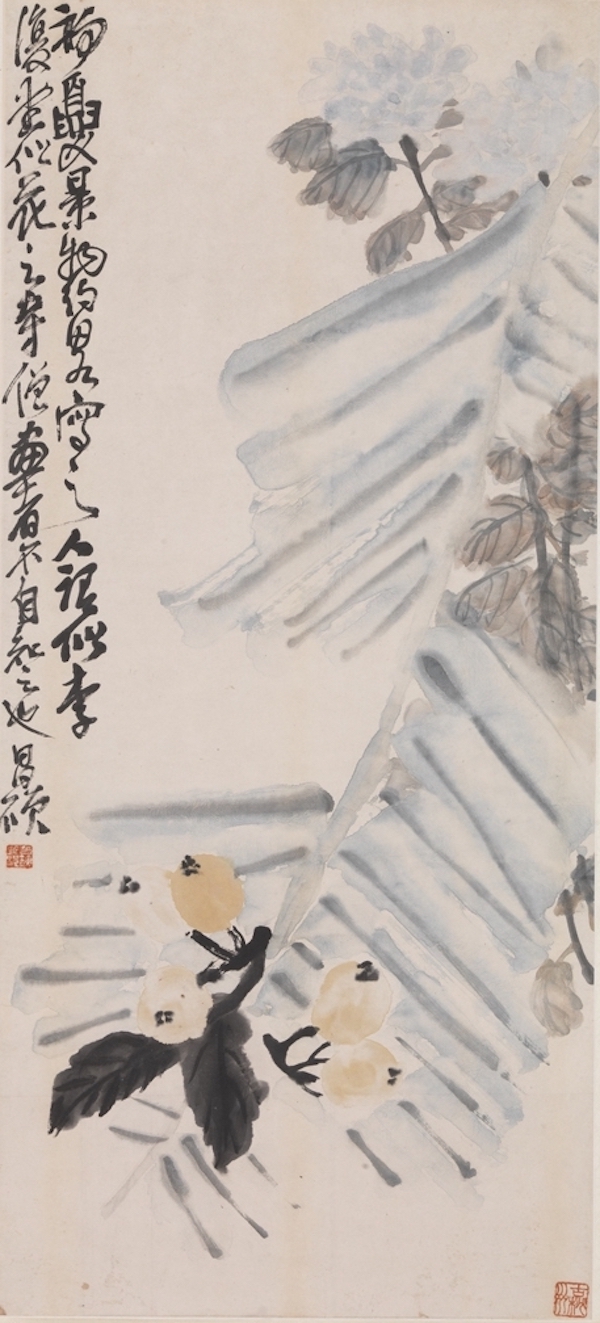
Qing Dynasty Wu Changshuo Flowers and Fruits Four-Screen Axis Loquat, Plantain and Chrysanthemum Collection of the National Palace Museum, Taipei
Wu Changshuo 's own writing in running script: "The early summer scene is sketched, and people say it looks like Li Futang, like a temple monk with flowers, and the painter doesn't know it." Changshuo.King Min Zhen loquat sparrow shaft

The loquat and sparrow shaft of the King of the People's Republic of China Collection of the National Palace Museum, Taipei
Wang Zhen (1867-1938), whose courtesy name is Yiting, was a native of Wuxing, Zhejiang, and was known as "Lord Haiyun" and "People from Bailong Mountain". Believing in Buddhism in his later years, the Dharma name is "Awakening Device". He is a rare genius of "business" and "art" in the history of Chinese art. Wang Zhen is a unique calligrapher and painter of the Shanghai School of Painting. It has made outstanding contributions to the continuation and inheritance of the Maritime School of Painting. He once recommended Wu Changshuo and became his disciple. Later, together with Wu Changshuo, he led the vigorous development of Shanghai-style painting art.People's King Zhenshou Peach Loquat Axis
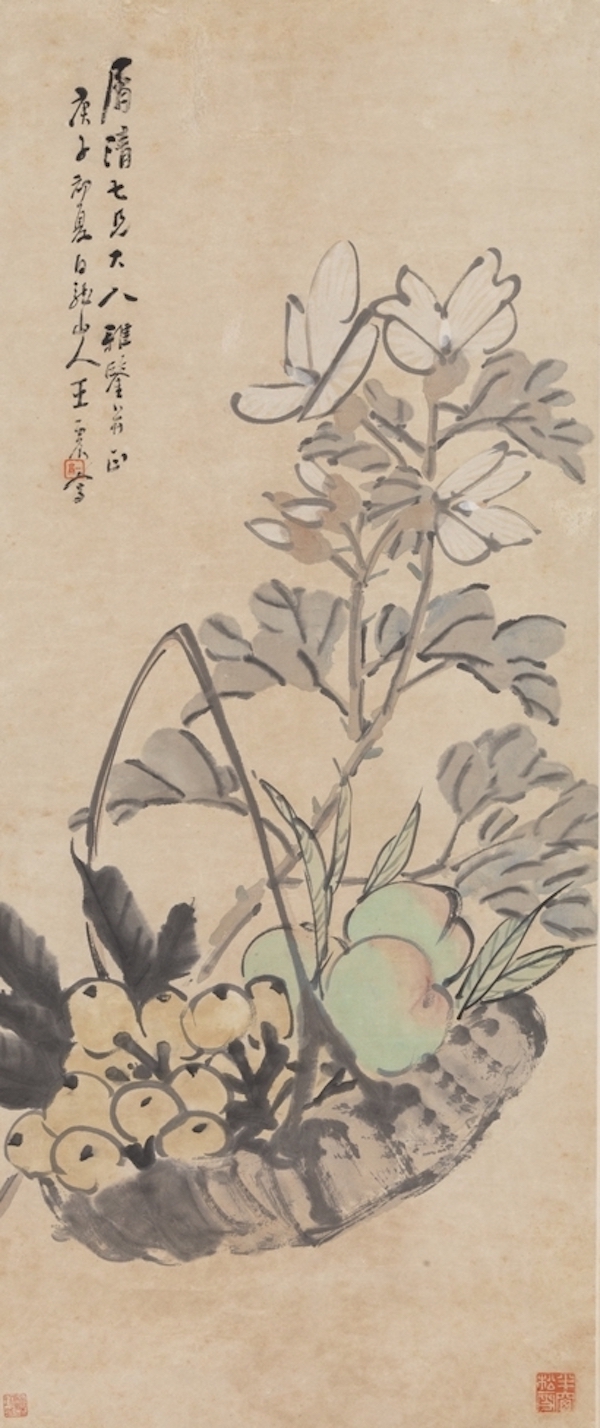
King Zhenshou Peach and Loquat Scroll Collection of the National Palace Museum, Taipei
Xu Beihong's loquat fruit in modern times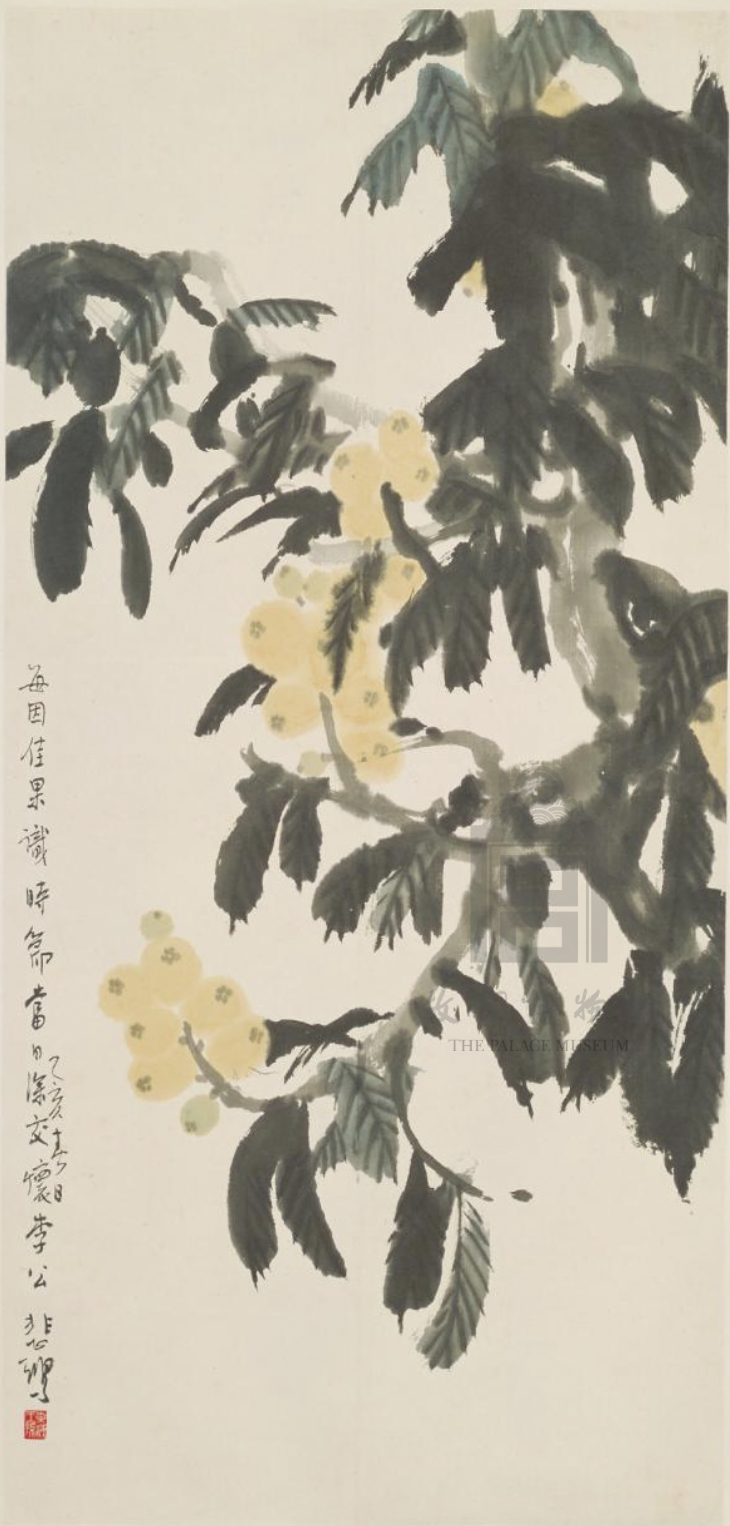
Modern Xu Beihong Loquat and Fruit Scroll Collection of the Palace Museum
Self-titled: "Every time I know the season because of the good fruit, I deeply care for Duke Li on the same day. The spring of Yihai is sad." The year of Yihai was 1935, when Xu Beihong was 40 years old.Drawing of a branch of a loquat tree. Under the blowing of the warm wind, the branches and leaves overlap, and the golden loquat is full of fruity fragrance, exuding the ripe beauty of the harvest season.
The author uses the freehand method of full ink to directly point dyeing and ink, and does not seek the similarities of objects and images, but only seeks the changes in the wet and dry and shades of the brush and ink on the highly absorbent raw rice paper. The dripping ink shows the freshness and vitality of the fruit and leaves full of juice. The whole picture shows Xu Beihong's unique understanding of Chinese literati's freehand brushwork.
The seal of "East Sea King and Sun" on the picture is one of Xu Beihong's favorite seals in Chinese paintings. Xu Beihong's hometown, Yixing, Jiangsu, is close to the East China Sea. Xu Maogong, a general in the early Tang Dynasty, was named Duke of Donghai County for his illustrious military exploits. Xu Beihong stamped this seal not only to express his pride as a descendant of the Xu family in the East China Sea, but also to add a legendary color and ancient meaning to his paintings.
(This article is compiled from the relevant materials of the Palace Museum and Taipei Palace Museum.)